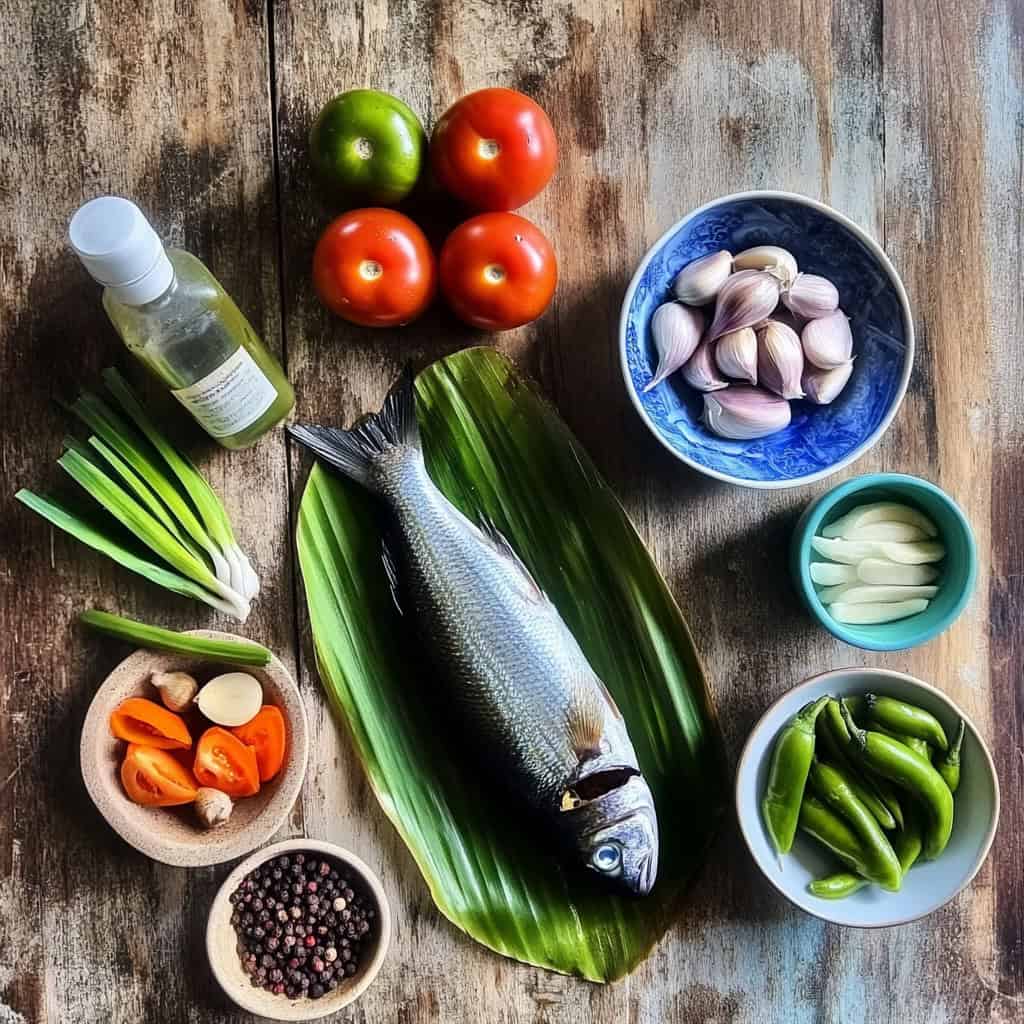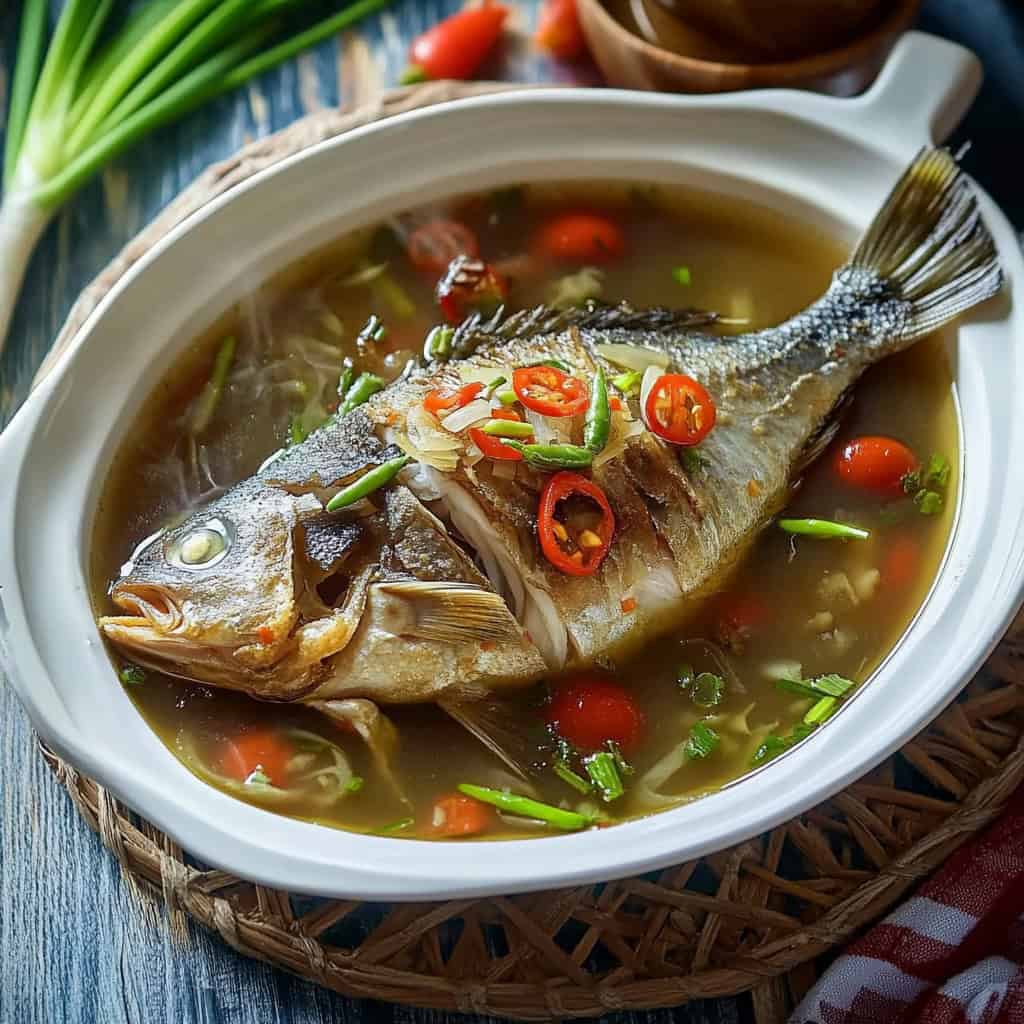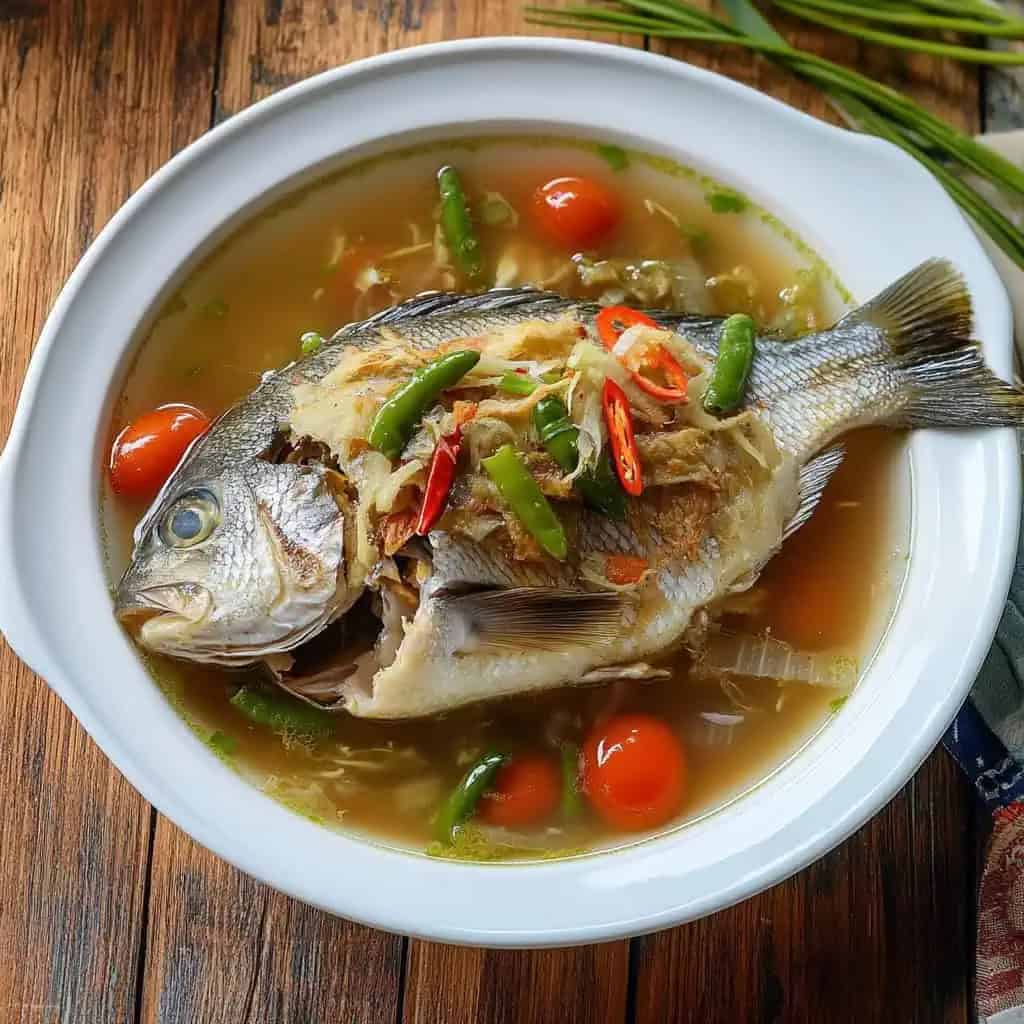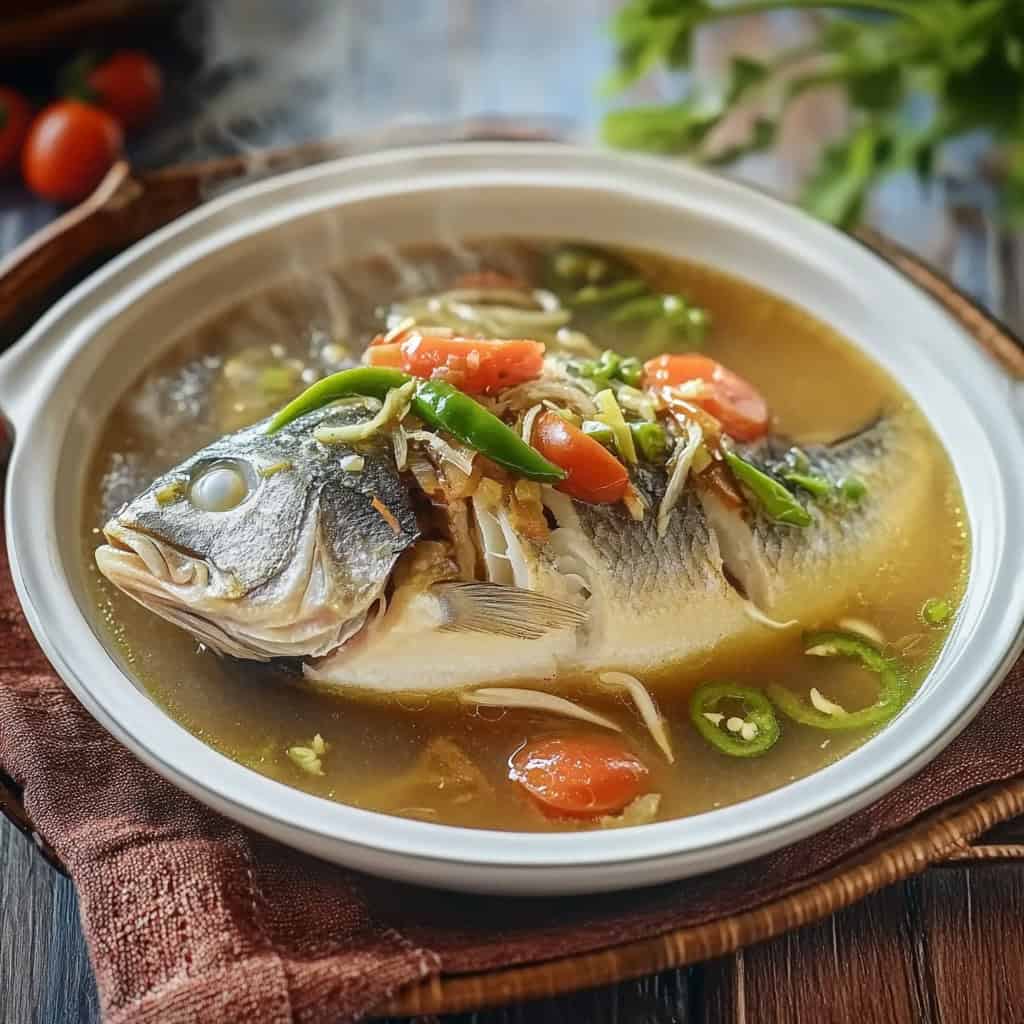Pinangat na Isda represents a masterful interplay of technique and tradition in Filipino cuisine. This refined preparation method elevates a simple fish stew into a sophisticated dish that exemplifies the complex flavor profiles characteristic of Philippine regional cooking. While sharing its name with the coconut milk-based Bicolano version, this interpretation focuses on achieving the perfect balance between rich and sour notes.
The preparation begins with premium pompano, selected for its firm flesh and natural oils that complement the dish's signature sour broth. The fish is first shallow-fried to achieve a golden exterior, creating a textural foundation that distinguishes this version from its more rustic counterparts. The concentrated broth, infused with either tamarind, bilimbi, or citrus, delivers the distinctive sourness that triggers "nangangasim," a uniquely Filipino physiological response to sour flavors.
What sets this recipe apart is its careful layering of aromatics: garlic, shallots, and ginger are sautéed to release their essential oils before introducing ripe tomatoes that provide both body and subtle sweetness to the broth. This methodical approach ensures that each element contributes to the final composition without overwhelming the delicate flavor of the fish. The result is a harmonious dish that honors traditional Filipino culinary principles while incorporating refined cooking techniques for enhanced flavor and presentation.
Jump to:

Why You'll Love This Recipe
- Authentic Filipino Flavors: Experience the unique combination of sour and savory that defines Filipino cuisine
- Perfectly Balanced: The crispy fried fish combines beautifully with the tangy broth
- Customizable Heat: Adjust the chilies to your preferred spice level
- Health Benefits: High in protein, omega-3 fatty acids, and essential vitamins
- Quick Preparation: Ready in under an hour
- Budget-Friendly: Uses accessible ingredients with suggested alternatives
Ingredients
Each ingredient in this recipe serves a crucial purpose in creating the perfect Pinangat na Isda. Pompano fish is chosen for its firm texture and natural oils that stand up beautifully to frying while remaining moist. The aromatic trio of garlic, shallots, and ginger forms the flavor foundation, while tomatoes add natural sweetness to balance the dish's sourness.
The souring agent (whether tamarind, bilimbi, or citrus) delivers the signature tangy flavor that makes this dish uniquely Filipino. Green chilies provide gentle heat without overwhelming the delicate fish, while spring onions add a fresh finish.
This thoughtful combination creates layers of flavor that develop throughout the cooking process.

For the Fish:
- 1 large pompano, cleaned, gutted, and scored
- Salt
- Freshly ground black pepper
- Cooking oil for frying
For the Broth:
- 2 large ripe tomatoes, chopped
- 1½ cups water
- Choice of souring agent: 4 tablespoons tamarind powder, 8 pieces bilimbi (kamias), or ½ cup calamansi or lemon juice
- 3 shallots, thinly sliced
- 4 cloves garlic, minced
- 1 thumb-sized ginger, minced
- 4 green chilies (siling haba)
- Fish sauce (patis) to taste
- 3 stalks spring onions, chopped
Equipment
- Large Wok (Kawali): Essential for both frying the fish and preparing the sour broth; provides the ideal surface area for even cooking
- Sharp Knife: For scoring the fish skin and chopping ingredients; ensures clean cuts without tearing the delicate fish
- Wooden Spoon (Sandok): Allows for gentle stirring without breaking apart the fish; prevents scratching your cookware
- Measuring Spoons: Ensures precise seasoning for a perfectly balanced flavor profile
- Cutting Board: Provides a stable surface for preparing vegetables and scoring the fish
- Fish Spatula: The thin, flexible edge helps carefully flip and handle the delicate fish without breaking it
- Small Bowl: For preparing and combining seasonings before adding to the main dish

How To Make
- Prepare the fish: Thoroughly clean the pompano fish. Score the skin on both sides with diagonal cuts spaced about 1 inch apart. Season the fish generously with salt and ground black pepper, making sure to season the inside cavity as well.
- Fry the fish: Heat enough oil in a wok for shallow frying over medium-high heat. Once hot, carefully place the fish and fry until golden brown and crispy on both sides, about 5-7 minutes per side. Remove the fish and set aside on paper towels to drain excess oil.
- Prepare the aromatics: Pour out most of the oil, leaving about 3 tablespoons in the wok. Add minced garlic, sliced shallots, and minced ginger. Sauté over medium heat until fragrant and shallots are softened, about 2-3 minutes.
- Develop the base flavors: Add the chopped tomatoes and cook until they start to soften and release their juices, about 4 minutes. If using bilimbi (kamias), add them now and gently mash with your wooden spoon as they cook to release their sour flavor.
- Create the broth: Pour in 1½ cups of water and bring to a boil. Lower the heat, cover the wok, and let it simmer for 3 minutes. If you're using bilimbi, give it an extra 3 minutes of simmering to extract more sourness.
- Combine with the fish: Place the fried fish back into the wok. If you're using tamarind powder or calamansi juice instead of bilimbi, add it now. Let everything simmer on low heat for 5 minutes to allow the fish to absorb the flavors.
- Final cooking: Carefully flip the fish over and continue simmering for 2 more minutes. Taste the broth – if it's too sour, add a little water. Season with fish sauce and more black pepper if needed.
- Finish the dish: Add the chopped spring onions and whole green chilies, then simmer for a final 2 minutes. Turn off the heat and let it rest for 2-3 minutes before serving to allow the flavors to fully develop.
- Serve: Transfer to a serving dish with the broth. Serve hot with steamed rice. Place extra fish sauce, chopped chilies, and calamansi on the side so everyone can adjust the flavors to their preference.

Tips from Lola's Kitchen
- Perfect scoring technique: Score the fish at a 45-degree angle and about ¼-inch deep for even cooking and maximum flavor absorption
- Crispy skin secret: Pat the fish completely dry before seasoning and don't move it while frying until a crust forms to achieve that coveted crispy skin
- Balanced broth: Always taste the broth before adding fish sauce - the saltiness should complement, not overpower, the sour notes
- Layered heat: Add chilies whole for subtle background heat, or chop them for more intensity throughout the dish
- Oil selection: Using the same oil from frying the fish adds depth to your broth, creating a more cohesive flavor profile
- Patient cooking: Allow the tomatoes to fully break down before adding liquid for a richer, more developed broth
- Gentle handling: Use two spatulas when flipping the fish to prevent it from breaking apart
- Rest before serving: The 2-3 minute rest period allows the flavors to meld and the fish to absorb more of the delicious broth
Substitutions
- Fish: While pompano is traditional, sea bass, grouper, or snapper work wonderfully. Look for fish with firm flesh and good fat content.
- Souring agent: Any combination of tamarind, bilimbi, calamansi, lemon, or lime can create the signature sour profile. Adjust quantities based on desired sourness.
- Shallots: Red onions can substitute, though they have a stronger flavor. Use about ¾ the amount called for.
- Green chilies: Bird's eye chilies (siling labuyo) create a spicier version - reduce the amount to 1-2 depending on heat preference.
- Spring onions: Chives or the green parts of leeks can provide a similar mild onion flavor.
- Fish sauce: In a pinch, soy sauce with a touch of salt can work, though the flavor profile will be slightly different.
Troubleshooting
- Broth too sour: Add water gradually, 2 tablespoons at a time, and adjust seasoning with a pinch of sugar to balance acidity.
- Fish breaking apart: Reduce handling and ensure you're using a proper fish spatula. Make sure the fish is fresh and firm.
- Broth too thin: Simmer uncovered for 5-7 minutes to reduce and concentrate flavors.
- Fish sticks while frying: Ensure oil is hot enough (350°F/175°C) before adding fish and that the pan is well-oiled.
- Tomatoes not breaking down: Cover and simmer for an additional 3-5 minutes, or gently mash with the back of your wooden spoon.
- Too spicy: Remove chilies immediately and add a splash more water and a teaspoon of sugar to balance the heat.
Storage & Reheating
- Refrigerate: Store in an airtight container for up to 2 days. The flavors often develop further overnight, making it even more delicious the next day.
- Freeze: Not recommended as the texture of the fish will deteriorate.
- Reheat: Place in a covered pan and heat on low until just heated through (about 5 minutes). Avoid boiling as this will overcook the fish.
- Note: Remove green chilies before storing to prevent the dish from becoming increasingly spicy over time.
- Serving after storage: Add a splash of fresh calamansi juice after reheating to brighten the flavors.

FAQ
Can I make this in advance for a dinner party?
While best served fresh, you can prepare all components up to 4 hours ahead. Fry the fish and make the broth separately, then combine and simmer briefly just before serving.
How do I know when the fish is perfectly cooked?
The flesh should be opaque and flake easily with a fork. If using a thermometer, the internal temperature should reach 145°F (63°C).
Is this dish very spicy?
The heat level is completely customizable. Green chilies add mild heat, but can be reduced or omitted for a milder version, or increased for more spice.
Can I use dried bilimbi (kamias) instead of fresh?
Fresh is preferred, but dried can be used - soak in warm water for 15 minutes first to rehydrate, then use about half the amount called for.
What makes this different from sinigang?
Pinangat has a more concentrated, less soupy broth than sinigang. It typically uses less water and focuses on the interplay between the fish oils and sour elements rather than being a full soup.
Can I add vegetables to this dish?
While not traditional for this specific version, you can add eggplant, okra, or long beans in the final 5 minutes of cooking for added nutrition and texture.
Why do you fry the fish first instead of just simmering it?
Frying creates a crispy exterior that holds the fish together better during simmering and adds a wonderful textural contrast to the finished dish.
How can I make this dish less oily?
After frying the fish, drain it thoroughly on paper towels. When sautéing aromatics, you can reduce the oil to just 1-2 tablespoons if preferred.
Related
Looking for other recipes like this? Try these:

Pinangat na Isda (Filipino Sour Fish Stew)
Equipment
- Large Wok (Kawali): For frying fish and preparing the broth
- Sharp Knife: For scoring the fish and chopping ingredients
- Wooden Spoon (Sandok): For gentle stirring without breaking the fish
- Measuring Spoons: For precise seasoning
- Cutting Board: For preparing vegetables
- Fish Spatula: For carefully flipping the delicate fish
- Small Bowl: For preparing seasonings
Ingredients
For the Fish:
- 1 large pompano Pampano, cleaned, gutted, and scored
- Salt Asin
- Freshly ground black pepper Paminta
- Cooking oil for frying
For the Broth:
- 2 large ripe tomatoes Kamatis, chopped
- 1½ cups water Tubig
- Choice of souring agent: 4 tablespoons tamarind powder Sampalok, 8 pieces bilimbi (Kamias) or ½ cup calamansi or lemon juice
- 3 shallots Sibuyas Tagalog, thinly sliced
- 4 cloves garlic Bawang, minced
- 1 thumb-sized ginger Luya, minced
- 4 green chilies Siling Haba
- Fish sauce Patis to taste
- 3 stalks spring onions Dahon ng Sibuyas, chopped
Instructions
- Start by thoroughly cleaning the pompano fish. Score the skin on both sides with diagonal cuts. Season the fish generously with salt and ground black pepper, making sure to season the inside cavity too.
- Heat enough oil in a wok for shallow frying over medium-high heat. Once hot, carefully place the fish and fry until golden brown and crispy on both sides, about 5-7 minutes per side. Remove the fish and set aside.
- Pour out most of the oil, leaving about 3 tablespoons in the wok. Add minced garlic, sliced shallots, and minced ginger. Sauté over medium heat until fragrant and shallots are softened, about 2-3 minutes.
- Add the chopped tomatoes and cook until they start to soften, about 4 minutes. If using bilimbi (kamias), add them now and gently mash with your spoon as they cook.
- Pour in 1½ cups of water and bring to a boil. Lower the heat, cover the wok, and let it simmer for 3 minutes. If you're using bilimbi, give it an extra 3 minutes of simmering to extract more sourness.
- Place the fried fish back into the wok. If you're using tamarind powder or calamansi juice instead of bilimbi, add it now. Let everything simmer on low heat for 5 minutes.
- Carefully flip the fish over and continue simmering for 2 more minutes. Taste the broth – if it's too sour, add a little water. Season with fish sauce and more black pepper if needed.
- Add the chopped spring onions and simmer for a final 2 minutes. Turn off the heat and let it rest for 2-3 minutes before serving.
- Serve hot with steamed rice. Place extra fish sauce, chopped chilies, and calamansi on the side so everyone can adjust the flavors to their taste.
- Note: You can control the sourness by adjusting the amount of souring agent (bilimbi, tamarind powder, or calamansi) to your preference. The broth should be more concentrated and less soupy than sinigang.
Tips from Lola's Kitchen
- Score the fish at a 45-degree angle for even cooking
- Don't move the fish while frying to achieve crispy skin
- Taste the broth before adding fish sauce - the saltiness should complement, not overpower
- Add chilies whole for subtle heat, or chop for more intensity
Nutrition
The Story Behind Pinangat na Isda
In the rich tapestry of Filipino cuisine, Pinangat na Isda stands as a remarkable example of how coastal communities transformed fresh catches into sophisticated dishes. This preparation method, dating back generations, emerged from the fishing villages of the Philippines where preservation techniques merged with culinary artistry to create something extraordinary.
The dish's name itself offers insight into its preparation method. "Pinangat" derives from the root word "pangat," which refers to the technique of cooking fish in souring agents. This method was historically vital for coastal communities, as the acidic environment not only enhanced flavor but also helped preserve their catch in the tropical climate before the advent of modern refrigeration.
While many Filipino dishes showcase the interplay between sour and savory flavors, Pinangat na Isda distinguishes itself through its concentrated broth. Unlike its more soup-based cousin, sinigang, or the vinegar-forward profile of paksiw, Pinangat achieves a perfect balance through its reduced cooking liquid. This concentration of flavors demonstrates the resourcefulness of Filipino cooks who maximized every ingredient at their disposal.
Regional variations of Pinangat exist throughout the Philippines, each telling its own story of local ingredients and preferences. The most notable distinction lies between this sour fish preparation and its namesake from the Bicol region, which employs coconut milk as its base. This divergence illustrates how Filipino cuisine adapted to regional ingredients while maintaining similar cooking techniques.
Contemporary iterations of Pinangat na Isda, including this refined version with its initial frying step, showcase how traditional dishes evolve while maintaining their essence. Modern Filipino chefs and home cooks continue to adapt the recipe, demonstrating the dish's versatility while preserving its fundamental character – the harmonious marriage of fresh fish with sour elements that creates the distinctive "nangangasim" sensation beloved in Filipino cuisine.
Today, Pinangat na Isda remains a testament to Filipino culinary heritage, embodying the sophisticated understanding of flavor combinations that developed through generations of cooking wisdom. Its enduring popularity in both home kitchens and restaurants speaks to its significance in Filipino food culture, making it not just a dish, but a celebration of Philippine coastal cuisine's rich history.










Comments
No Comments